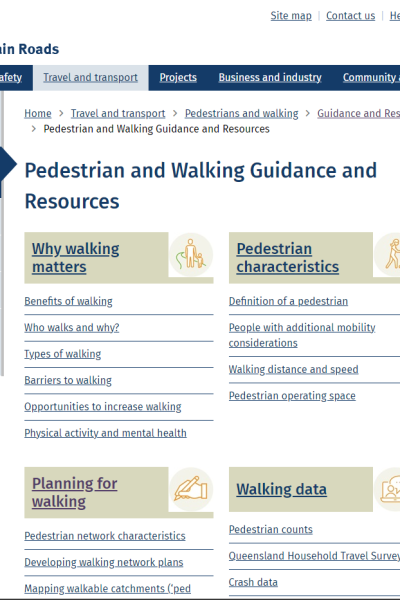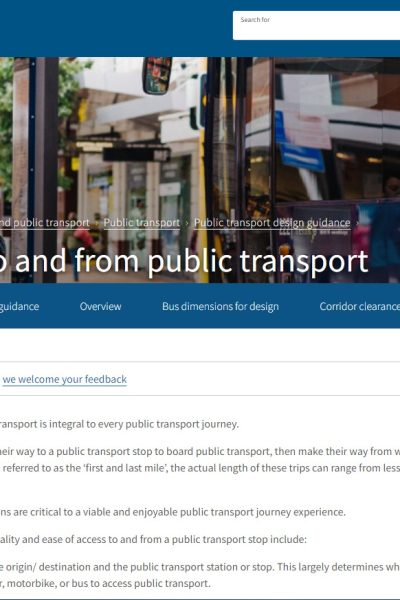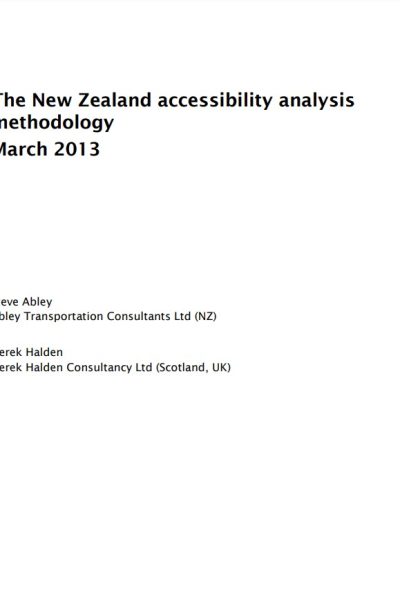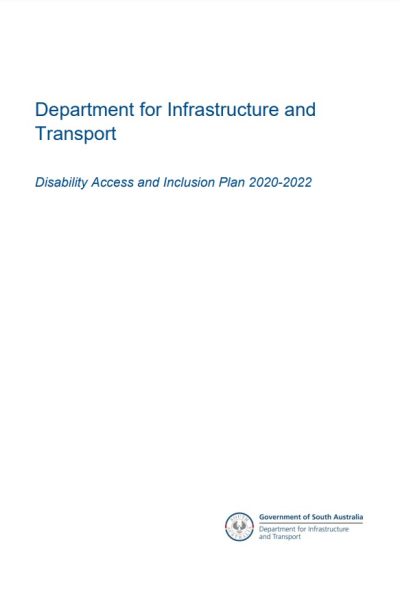Resources
This page contains some key resources on walking and cycling, including an archive of the documents produced by the Australian Bicycle Council.
| Date Added | |||
|---|---|---|---|
 |
Universal access Department of Transport and Main Roads, Queensland On this page: |
27/10/2023 | View |
 |
Pedestrian and Walking Guidance and Resources Department of Transport and Main Roads, Queensland Including:
|
13/10/2023 | View |
 |
Walking Network Planning Guidance Department of Transport and Main Roads, Queensland More people will walk when everyday destinations are connected by comfortable, direct, safe and accessible routes. Walking network plans (WNPs) are a first step to creating better places to walk. The Queensland Government is committed to achieving the Queensland Walking Strategy 2019–2029 vision of walking becoming 'an easy choice for everyone, every day'. When we talk about walking, we also include running and moving with the help of a mobility device (such as a wheelchair, mobility cane or a walking frame). The following guidance supports practitioners to prepare WNPs and a prioritised works program to make the plan a reality. |
13/10/2023 | View |
 |
Disability Standards for Accessible Public Transport 2002 (Transport Standards) Department of Infrastructure, Transport, Regional Development, Communications and the Arts The Disability Discrimination Act 1992(the Act) is in place to eliminate discrimination against people with disability as far as possible, and to promote community acceptance of the principle that people with disability have the same fundamental rights as all members of the community. The Act provides that direct and indirect discrimination on the basis of disability is unlawful in a broad range of areas of public life, including and access to goods, services and facilities. The Disability Standards for Accessible Public Transport 2002 (Transport Standards) provide requirements for public transport operators and providers to make their services accessible and remove discrimination against people with disability. The Transport Standards took effect on 23 October 2002. The Transport Standards apply to train, tram, bus and coach, ferry, taxi and aviation services and are designed to provide certainty to providers and operators of public transport services and infrastructure about their responsibilities under the Disability Discrimination Act 1992. |
13/10/2023 | View |
 |
Getting to and from public transport Waka Kotahi NZ Transport Agency Getting to and from public transport is integral to every public transport journey. All passengers must make their way to a public transport stop to board public transport, then make their way from where they disembark to their final destination. Often referred to as the ‘first and last mile’, the actual length of these trips can range from less than 100m to many kilometres. First and last mile connections are critical to a viable and enjoyable public transport journey experience. Key issues relating to the quality and ease of access to and from a public transport stop include:
It is important that those involved in public transport planning consider the whole of the passengers' journey. When planning for public transport journeys, the following questions should be considered:
|
19/05/2023 | View |
 |
Research Report 512 The New Zealand accessibility analysis methodology Waka Kotahi NZ Transport Agency This research considers land use and transport accessibility drawing on international practice from the UK, Europe, USA and Australia. An objective of the research was to define accessibility and propose a methodology for how accessibility could be measured and quantified in New Zealand, both at a neighbourhood or a wider area such as a suburb, city or region. The result of the research was an understanding of other countries’ experiences developing and setting accessibility policy and the success of those approaches. This is important because if New Zealand chooses to set explicit accessibility policy, the research explains how that might be best achieved. A second result of the research was the development of a new methodology for calculating accessibility that draws on overseas and improved practice. The new methodology quantitatively measures accessibility taking into consideration different modes of travel (walk, cycle, private motor vehicle etc), travel behaviour (ideally using logistic decay functions), destinations (origin or destination based), activities (consumed or supplied) and multiple opportunities (saturations). The calculation methodology was piloted on Christchurch (a city of some 350,000 people) and the accessibility of every household quantified to a variety of destinations including doctors, supermarkets and schools. Keywords: accessibility, cycling, GIS, indicators, journey planning, methodology, modelling, networks, New Zealand, public transport, transport, walking |
19/05/2023 | View |
 |
Research Report 363 Accessibility planning methods Waka Kotahi NZ Transport Agency This research investigated the applicability of accessibility planning in New Zealand as a tool for assessing and improving personal access to essential services for all New Zealanders. It canvassed international accessibility planning practices in England, the Netherlands and Southern California to understand the various drivers for its introduction and the different approaches taken in its implementation. All three case studies share the goal of improving individuals’ access to activity centres and recognise that accessibility planning is best undertaken at the local level with some form of central government guidance and monitoring. The English comprehensive accessibility planning framework has been adapted to New Zealand’s existing social services and local government legislative and institutional environment and the recently legislated changes to the government land transport sector. The resulting recommended framework employed a collaborative approach to assess and improve people’s accessibility to employment, food shopping, health, education and social services across New Zealand. All levels of government would participate in the assessment of accessibility, development of priorities, indicators and action plans and monitor progress against outcomes, within government frameworks. Transport actions developed by regional accessibility partnerships to address regional problems would feed directly into their regional land transport programmes for prioritisation for funding. |
19/05/2023 | View |
 |
Accessibility Waka Kotahi NZ Transport Agency Key design parameters for accessibility such as kerb arrangements, access ramps, tactile ground surface indicators, and pedestrian movement. |
19/05/2023 | View |
 |
Disability Access and Inclusion Plan 2020-2022 Department for Infrastructure and Transport, South Australia The Disability Access and Inclusion Plan details the Department for Infrastructure and Transport’s commitment to promoting, protecting and enhancing the rights of people living with disability in South Australia. The Plan includes clear and measurable actions and targets designed through community and Departmental consultation to give effect to the priority areas of the first State Disability Inclusion Plan 2019-2023, as they relate to the purpose and activities of the Department. |
19/05/2023 | View |
 |
Disability Inclusion Action Plan 2018 – 2022 Transport for NSW The NSW Government is funding numerous projects under the Transport Access Program to upgrade train stations, ferry wharves and interchanges. New infrastructure, such as the Sydney Metro Northwest and the CBD and South East Light Rail, are being built to the very highest standards of accessibility. We have invested in new trains, buses and ferries – all which have improved accessibility features. The Disability Inclusion Action Plan 2018-2022 builds upon the successes of the previous plan, the Disability Action Plan 2012-2017, to set an ambitious agenda for the next five years. This document presents a vision of a more accessible future for transport in NSW. More importantly, it outlines concrete, measurable steps towards achieving that vision. |
19/05/2023 | View |
 |
Disability Access and Inclusion Plan Department of Transport, Main Roads Western Australia and Public Transport Authority The PTA, together with our Transport Portfolio partners Main Roads and the Department of Transport, has developed the Transport Portfolio Disability Access and Inclusion Plan (DAIP) for 2022-2027. The DAIP aims to ensure that people with a disability have the same opportunity as other people to access PTA public transport services, information and facilities. The PTA has also developed the PTA Implementation Plan for Transport Portfolio Disability Access and Inclusion Plan which demonstrates our commitment to providing a high level of independence for all passengers. |
19/05/2023 | View |
 |
Accessibility Policy Public Transport Authority Western Australia The PTA Accessibility Policy has been developed as the overarching document for access. Our Accessibility Policy outlines how the PTA shall, as far as reasonably practical, provide public passenger transport services and facilities that are accessible to all passengers. |
19/05/2023 | View |
 |
Transport Accessibility Strategy Department of Transport and Planning The Victorian Government is working to ensure our public transport network is inclusive and accessible for all Victorians. In Victoria, 1.1 million people have either a physical or non-physical disability. Our ageing population and those with other mobility barriers also need accessibility support on the transport network. |
19/05/2023 | View |
 |
Accessibility and Inclusion Strategy Summary Department of Transport and Main Roads Queensland TMR commits to lead the delivery of accessible and inclusive transport products, services, information and infrastructure, and TMR workplaces and work practices. |
19/05/2023 | View |
 |
Accessibility and Inclusion Plan 2023–2024 Department of Main Roads and Transport Queensland The TMR Accessibility and Inclusion Plan 2023–2024 was developed to outline the practical actions TMR will take over the next 2 years to deliver our vision. To develop the plan, we looked at best practice research, data and analysis, international accessibility and inclusion reporting frameworks, key indicators of success, and we engaged our customers, partners and staff. This plan outlines 27 actions across 3 key pillars:
We will report our progress on the plan actions and in 2024 we will develop an updated plan based on key learnings, co-design activities and emerging trends. This plan is available in the following accessible formats:
|
19/05/2023 | View |
 |
Accessibility and inclusion strategy Department of Main Roads and Transport, Queensland The Accessibility and Inclusion Strategy (AIS) will ensure that TMR's approach to accessibility and inclusion aligns with the Queensland Government's Advancing Queensland's Priorities. |
19/05/2023 | View |
